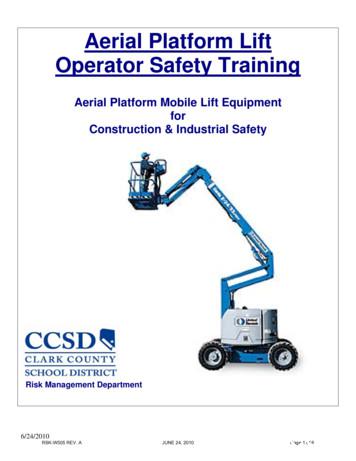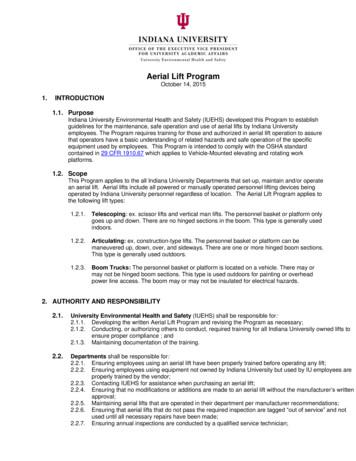Aerial Platform Lift Operator Safety Training
Aerial Platform LiftOperator Safety TrainingAerial Platform Mobile Lift EquipmentforConstruction & Industrial SafetyRisk Management Department6/24/2010RSK-W505 REV. AJUNE 24, 2010Page 1 of 6
QUICKCARDTMAerial LiftsSafety TipsAerial lifts include boom-supported aerial platforms,such as cherry pickers or bucket trucks. The majorcauses of fatalities are falls, electrocutions, andcollapses or tip overs.Safe Work Practices Ensure that workers who operate aerial lifts areproperly trained in the safe use of the equipment. Maintain and operate elevating work platforms inaccordance with the manufacturer's instructions. Never override hydraulic, mechanical, or electricalsafety devices. Never move the equipment with workers in anelevated platform unless this is permitted by themanufacturer. Do not allow workers to position themselvesbetween overhead hazards, such as joists andbeams, and the rails of the basket. Movement ofthe lift could crush the worker(s). Maintain a minimum clearance of at least 10 feet,or 3 meters, away from the nearest overhead lines. Always treat powerlines, wires and other conductors as energized, even if they are down or appearto be insulated. Use a body harness or restraining belt with alanyard attached to the boom or basket to preventthe worker(s) from being ejected or pulled from thebasket. Set the brakes, and use wheel chocks when onan incline. Use outriggers, if provided. Do not exceed the load limits of the equipment.Allow for the combined weight of the worker, tools,and materials.OccupationalSafety and HealthAdministrationU.S. Department of Laborwww.osha.gov (800) 321-OSHARSK-W505 REV. AJUNE 24, 2010OSHA 3267-09N-05For more complete information:Page 2 of 6
Aerial Lift DefinitionsAerial LiftsDevices or equipment to lift workers and tools to an elevatedworksite. Includes, scissors lifts, aerial man-lifts, and buckettrucks.Bare-handworkA technique of performing live-line maintenance on energizedconductors and equipment whereby one or more authorizedpersons work directly on an energized part after having been raisedand bonded to the energized conductors or equipment. CCSD doesnot conduct this type of task and should refer such work toauthorized electrical contractors.Category “A” Aerial Device An aerial lift (usually a bucket truck) that has dielectric propertiesin order to resist electrical hazards. The dielectric components shallbe certified annually to assure dielectric value.Lower ControlsControls situated at ground level of the lift that can control the liftplatform. Usually used for emergency operation only.MSADMinimum Safe Approach distance (to live electrical lines,equipment, and components.) This does not apply to line trucks.See manufacturer’s operator manuals for more information.OperatorsQualified persons who directly control the movement of the aeriallift. These persons are authorized, trained, and engaged in the liftoperation.OwnersPersons or entities such as CCSD who have possession of an aeriallift. CCSD departments that lease or rent the equipment can beconsidered owners. Owners conduct maintenance and inspectionson the lifts.Upper ControlsControls situated in the platform, man-lift, or bucket part of theaerial lift that also controls the movement of the lift. These are themain controls used during operation of the lift.UsersPersons or entities such as CCSD who have care, control, andcustody of the aerial lift.RSK-W505 REV. AJUNE 24, 2010Page 3 of 6
Aerial Lift Operator Warnings and InstructionsThe aerial lift is used only for intended applications as defined in the equipment'soperating manual. The following recognized safety practices shall be used:1.2.3.4.5.6.7.8.9.10.11.12.13.14.15.Operators shall not use the lift in an unauthorized manner.All platform occupants shall use fall protection (e.g., full body harness, shockabsorbing lanyard) connected to the anchorage point(s) provided on the platform.A hard hat shall be worn at all times when operating aerial lifts including exposedemployees below.Other personal protective equipment, (e.g., eye, foot, hand, clothing) shall beworn as required.The slope and grade for which the platform is rated shall not be exceeded. AerialLifts may be equipped with tilt or other motion/capacity warning alarms. Thesealarms shall be operational. The limit switch shall not be altered or disabled.Operators shall not depend upon the tilt alarm as a level indicator.The deployment of stability-enhancing means, such as outriggers, outriggerpads, stabilizers or extendible axles, shall be utilized.The guardrail system shall be used per manufacturer's specifications. Entry gatesor chains shall be closed before operating the lift.Operators shall not overload an aerial lift. Occupants and equipment shall notexceed the maximum platform capacity (or the maximum capacity of the platformextension when so equipped).Safe distances, including overhead clearance, shall be maintained between theoperator, the machine, and other objects. Electrocution hazards shall be avoided.Operators shall maintain safe distances from electrical power lines, conductors orbus bars. They shall allow for boom or platform movement or electrical line swayor sag. Operators shall follow minimum safe approach distances (MSAD); seeAppendix G in this handout.Only Category "A" aerial lifts shall be used for bare-hand electrical work. Checkmanufacturer's instructions for testing, locking, tagging, and grounding.Operators shall not drive the mobile chassis close to an obstruction. The operatorshall place his/her machine, then use the raise, swing, and boom functions to getin close. Operators shall use the slowest speed for such movements to avoid"bounce" of the platform.Operators shall not sit, stand, or climb on the platform guardrails or edge of thebucket. They shall maintain a firm footing on the platform floor at all timeskeeping the platform free of tripping hazards.The use of railings, planks, ladders, scaffolds or any other device in or out of thework platform for achieving additional height or reach is prohibited.Areas around aerial lift operations shall be barricaded to prevent injury topedestrians and other workers. When other moving equipment is present,precautions, such a warnings, barriers, or flashing lights shall be used.Observations shall be conducted on an ongoing basis to detect any deficienciesin equipment or method of use. Operator shall cease operation of the lift if anysuspected malfunction occurs. Problems or malfunctions must be reported to thesupervisor as soon as possible. Repairs must be made before using the aeriallift.RSK-W505 REV. AJUNE 24, 2010Page 4 of 6
.33.34.35.Aerial lifts with internal combustion engines operating inside a building, or otherunusual conditions, are prohibited unless evaluated and permitted bymanagement.Care shall be made to avoid entanglement with hoses, wires, cables, or otherequipment while operating the lift.Before lowering the lift, the work area must be clear of workers, equipment, orother obstructions.Re-fuel or recharge the lift only in well-ventilated areas with the use of properpersonal protective equipment and means of fire extinguishing.For counter-weight purposes, batteries weighing less than the original batteriesfrom the manufacturer shall not be used.The platform shall not be steadied by positioning or attaching the lift againstanother object.Operators shall not modify the lift by attaching fixed or overhanging loads, tools,or equipment outside the platform perimeter. Load limits shall be adhered to at alltimes. Modifications will only be approved with written permission from themanufacturer.The lift shall not be used as a crane or jack, used to push or pull other objectsunless designated by the manufacturer.Operators shall limit travel speed according to conditions.Traveling 50-feet or more with the aerial lift shall be done in the lowered position.Extensible or articulating booms shall be retracted or folded prior to relocation.Driving requirements and repositioning shall include maintaining a clear view ofthe support surface and route of travel.Stunt driving is prohibited.When the aerial lift is left unattended, it shall be secured to protect fromunauthorized use.Personnel shall leave the lift when attempting to free a snagged lift. Entering orexiting an elevated platform must be conducted per the manufacturer’sinstructions. The use of 2- lanyards will be required as part of your fall protectionsystem to ensure 100% fall protection when leaving or returning to an elevatedlift.Aerial lift occupants must use the 3-point contact when mounting or dismountingthe platform or bucket.Support requirements for the platform shall be adequate before the work begins.Know the weight of the lift plus its load capacity, and understand the structuralstrength of the support the lift will be placed on.The aerial platform shall be leveled using the manufacturer’s outriggers andleveling devices and the brakes set.Operators shall not use the lift as a ground for welding.Only one designated person should operate the controls. Operators shall neverallow any one to tamper with, service, or operate a machine from the lowercontrol station while the platform is occupied except in an emergency.Operators shall not operate the lift during inclement weather as determined bythe manufacturer’s design and management’s approval.RSK-W505 REV. AJUNE 24, 2010CCSD Risk Management Department 6/25/2010Page 5 of 6
MSAD(Minimum Safe Approach Distance)to Energized (Exposed or Insulated) Power LinesVoltage RangePhase to Phase0 to 300 V 300 to 50 KV 50 KV to 200 KV 200 KV to 350 KV 350 KV 500 KV 500 KV to 750 KV 750 KV to 1000 KVRSK-W505 REV. AMSADFeet101520253545MetersAvoid Contact3.054.606.107.6210.6713.72JUNE 24, 2010Page 6 of 6
Aerial Platform Lift Operator Safety Training Aerial Platform Mobile Lift Equipment for Construction & Industrial Safety Risk Management Department 6/24/2010 RSK-W505 REV. A JUNE 24, 2010 Page 1 of 6. QUICK CARD TM Aerial Lifts Safety Tips Aerial lifts
Jan 03, 2018 · flying squirrel moose cut moose bobcat glades runner up porcupine run deer round-a-bout cub carpet low road bobcat chute bus lot lot 3 lot 2 lot 1 lot 4 lot 5 lift e / face lift lift a / mixing bowl lift e / face lift lift b / bear lift lift k / cloudsplitter gondola lift h / mountain run lift i / freeway lift lift g / little whiteface lift g .
Aerial Lift Safety Program. Provide specific operational training for each aerial lift. Observe the operation of aerial lifts, and correct unsafe practices. 6.3 Operators Read the Aerial Lift Safety Program. Complete the Daily Pre-Use Inspection Che
Prior to operating an aerial lift, the employee shall perform a pre-operation safety inspection as follows using the appropriate Aerial Lift Inspection Checklist in Appendix B. 3.2.1. The inspection must be made daily or when the aerial lift is used; 3.2.2. When aerial lifts are used on a r
Aerial Lift Stability . safety standards related to aerial/scissor lifts. SCOPE . used in construction/industry. Vehicle Mounted Aerial Lift / Bucket Truck . The lift platform is an integral part of
the aerial/scissor lift training, an employee must have successfully completed train-the-trainer course. Familiarization: Providing information regarding the control functions and safety devices for the aerial /scissor lift to an operator of the equipment. Insulated Platform: A platform designed and tested to
with an emphasis on aerial lift and other large equipment or vehicle maintenance. 6) Describe your proposed approach and methodology for aerial lift and other large equipment or vehicle maintenance. 7) Please describe your experience with aerial lift and other large equipment or vehicle maintenance, especially for public sector clients.
Before Operating Aerial Lifts Do not modify aerial lift without written permission Check safety devices, operating controls before each use Check area in which aerial lift will be used for: ¾ Level surface (Do not exceed manufacturer slope recommendations) ¾ Holes, drop-offs, bumps, debris, etc. ¾ Overhead obstructions and overhead power linesFile Size: 465KB
1000 days during pregnancy and the first 2 years of life, as called for in the 2008 Series. One of the main drivers of this new international commitment is the Scaling Up Nutrition (SUN) movement.18,19 National commitment in LMICs is growing, donor funding is rising, and civil society and the private sector are increasingly engaged. However, this progress has not yet translated into .























